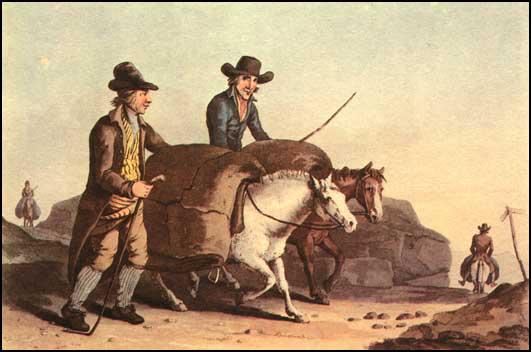Cloth Merchant
In the 18th Century the production of textiles was the most important industry in Britain. Most of the work was carried out in the home and was often combined with farming. Most cloth was made from either wool or cotton, but other materials such as silk and flax were also used.
The woven cloth was sold to merchants called clothiers who visited the village with their trains of pack-horses. The clothiers then took the finished cloth to the nearest market town. The largest market in the England was held in Leeds. Some of the cloth was made into clothes for people living in this country. However, a large amount of cloth was exported.

Primary Sources
(1) Daniel Defoe, A Tour Through the Whole Island of Great Britain (1724)
Generally speaking, the spinning work is performed by the poor people who live in villages and scattered houses. The clothiers, who generally live in the towns, send out the wool weekly to the spinners. At the same time, the clothiers' servants and horses bring back the yarn that they the spinners have spun and finished.
Each clothier must keep a horse, perhaps two, to fetch and carry for the use of his manufacture, to fetch home his wool and his provisions from the market, to carry his yarn to the spinners, his manufacture to the fulling mill, and, when finished, to the market to be sold.
(2) Edward Baines, The History of the Cotton Manufacture (1835)
In the 17th century the extent of mercantile establishments, and the modes of doing business, were extremely different from what they are at present. Commercial enterprise was exceedingly limited. Owing to the bad state of the roads, and the entire absence of inland navigation, goods could only be conveyed on packhorses.
(3) Daniel Defoe, A Tour Through the Whole Island of Great Britain (1724)
Leeds is a large, wealthy and populous town, it stands on the north bank of the River Aire, or rather on both sides of the river, for there is a large suburb or part of the town on the south side of the river, and the whole is joined by a stately and prodigiously strong stone bridge, so large, and so wide, that formerly the cloth market was on the bridge itself. The increase in the manufacturers and of the trade, soon made the market too great to be confined to the bridge, and it is now kept in the high street, beginning from the bridge, and running up north almost to the market house, where the ordinary market for provisions begin.
The market is here twice a week. At seven the market bell rings (in the summer earlier, in the depth of winter a little later). It would surprise a stranger to see in how a few minutes, without hurry or noise, and not the least disorder, the whole market is filled; all the boards upon the tressels are covered with cloth, close to one another as the pieces can lie long ways by one another, and behind every piece of cloth, the clothier standing to sell it.
Merchants in Leeds go all over England with droves of pack horses, and to all the fairs and market towns all over the whole island. Other buyers of cloth send it to London. They not only supply shopkeepers and wholesale men in London but for exportation to the English colonies in America and to merchants in Russia, Sweden, Holland and Germany.
